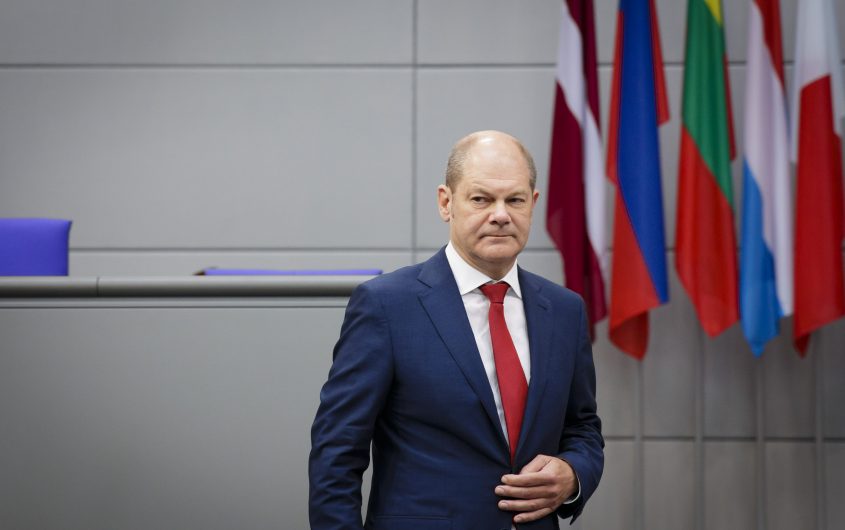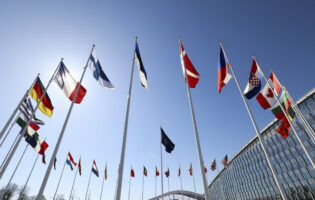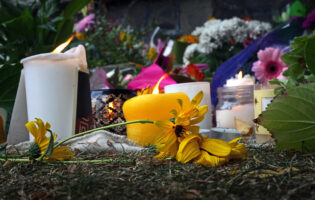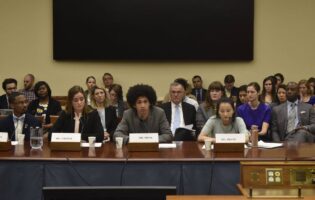
OSCE Parliamentary Assembly via Flickr
The Zeitenwende: Germany’s Reluctant Revolution

Nicole Koenig
Jacques Delors Centre
Nicole Koenig is a DAAD/AICGS Research Fellow from May through June 2022.
She is Deputy Director of the Jacques Delors Centre at the Hertie School in Berlin. She leads the Centre’s think tank work on EU foreign and security policy, institutions and democracy, as well as migration policy. Her own research focuses on European and German security and defense policy, EU-NATO relations, and Franco-German cooperation. Prior to joining the Jacques Delors Centre, she worked for various European think tanks and universities including the Trans European Policy Studies Association in Brussels, the Istituto Affari Internazionali in Rome, the Institute for Advanced Sustainability Studies in Potsdam, and the Department of War Studies at King’s College in London. She was awarded the 2019-2020 Europe’s Futures Fellowship by the Vienna-based Institute for Human Sciences.
Nicole Koenig holds a PhD in Politics and International Relations from the Universities of Cologne and Edinburgh. She holds a master’s degree in Politics and Management from the University of Constance and one in EU International Relations and Diplomacy from the College of Europe in Bruges. She published a monograph on EU security policy as well as a broad range of think tank and academic papers and frequently appears in international media.
During her fellowship at the AICGS, Nicole Koenig will focus on the connection between the EU’s Strategic Compass for Security and Defence (March 2022) and NATO’s new Strategic Concept (due in June 2022). Both documents are heavily influenced by the Russian war on Ukraine as well as national strategy shifts such as the German Zeitenwende. Nicole Koenig will assess the implications of these strategy reviews for transatlantic security and defense cooperation.
The DAAD/AICGS Research Fellowship is supported by the DAAD with funds from the Federal Foreign Office.
Talking about a revolution
Three days into the Russian invasion of Ukraine, Chancellor Olaf Scholz announced a revolution in German foreign policy. At an extraordinary session of the German Bundestag on February 27, 2022, he called Putin’s war a watershed moment (Zeitenwende) and announced far-reaching policy shifts. These included the delivery of weapons to Ukraine and the creation of a €100 billion special fund for the military with the aim of investing more than two percent of GDP on defense. He also underscored the country’s continued role in nuclear sharing and announced the replacement of the Tornado jets with the F-35, thereby ending a long and controversial domestic debate. His speech came shortly after two other noteworthy shifts: the decision to halt the certification of the Nord Stream 2 gas pipeline and to exclude some Russian banks from the SWIFT financial payment system.
Taken together, these measures mark one the most important changes in Germany’s foreign policy since World War II. They contrast with two historically rooted principles: the concept of “change through trade” that long characterized Germany’s Russia and Eastern policy (Ostpolitik) and the political and military restraint lying at the heart of its strategic culture.
Germany’s partners welcomed these bold announcements. For a moment, it seemed as if Germany had woken up from its post-Cold War slumber. Four months later, the question is whether it has really woken up, and if so, for how long? Skeptics recall the so-called “Munich Consensus” of 2014 when Germany’s foreign policy elite announced a shift toward greater international responsibility, including the use of force as a last resort. In practice, the shift was far less consequential than expected.
What do the first four months tell us about the scope, pace, and durability of the Zeitenwende? What should Germany do next to overcome internal constraints, advance its security interests, and meet the expectations of its allies and partners? This essay focuses on the security dimension of the Zeitenwende and builds on insights from over fifteen background conversations with EU and U.S. security and defense experts held in May and June 2022.
A sluggish start
The proclaimed revolution contrasted with its sluggish start. This was particularly the case for weapon deliveries. It took the government two months to agree that this also included heavy weapons. Two months later, Germany had still not delivered them. It was equally slow to implement the so-called “ring swap” decision of April, whereby European neighbors could apply for the replacement of Soviet-era weapons delivered to Ukraine with more modern German ones. In late May, the Polish president openly accused the German government of breaking its word. A few days later, Scholz seemed to gain ground by announcing the delivery of the IRIS-T air defense system to Ukraine. It then transpired that the system would only be ready for delivery in November/December. An analysis by the Kiel Institute for World Economy underlined the discrepancy between announcements and delivery: while Germany was number four worldwide in terms of the value of promised weapons to Ukraine, it had only delivered one-third by mid-June.
Germany’s hesitant start was widely criticized. Its fiercest critics, aside from Ukraine itself, were Poland and the Baltic countries. In mid-May, Latvia’s defense minister bluntly stated that the latter’s trust in Germany was “close to zero.” While members of the U.S. administration avoided direct criticism, there was growing frustration in Washington’s policy community that Germany had to be dragged along on every step. As security analyst John Deni put it, “Germany must still overcome the habit, conditioned by decades of subordinated geopolitical ambition, of being the last to do what is necessary when it comes to international or even European security.” This was certainly not the kind of leadership that the United States would expect from Europe’s leading economic and soon military power.
Domestic stumbling blocks
At the same time, there was a lot of appreciation in the U.S. administration that the German government was struggling with complicated internal dynamics while standing in the spotlight. These dynamics are worth a closer look as they will continue to determine the pace, scope, and durability of the Zeitenwende. Four interlinked factors contributed to Germany’s hesitant start.
1. Communication
The chancellor’s daring speech was followed by defensive and at times cryptic communication. In mid-April, he dismissed three Bundestag committee chairs as “boys and girls” when they called for military support after a joint visit to Kyiv. One month after the decision to deliver heavy weapons, he issued a tweet questioning “whether violence should be met with violence” and whether peace could only be attained without weapons. Meanwhile, the government’s explanations for the delays in the weapon deliveries shifted and were partly contradictory. They ranged from the risk of being dragged into the war to logistical issues, gaps in the Bundeswehr arsenal, the time needed to train Ukrainian soldiers, and the need for NATO approval—a claim that allies and partners rapidly dismissed.
American interlocutors were puzzled about the chancellor’s communication style, which some described as “incredibly awkward” and hard to interpret. By contrast, most were impressed with the communication of the Green party’s economy and foreign ministers that openly articulated the pros and cons of different options before explaining their preferred course.
2. Party politics
Party politics was a second stumbling block. All governing parties had to give up long-standing positions. Meanwhile, they were being scrutinized by the Christian Democrats, eager to defend their turf in the field of foreign and security policy. The shift was most dramatic for the Social Democrats, which had to reassess their Ostpolitik and the culture of restraint while being at the helm of the Zeitenwende. The clear-cut shift of the Greens, a party with a strong pacifist tradition, was certainly most surprising. Meanwhile, the FDP had to move on its anti-deficit stance to support the credit-based fund for the military.
The drawn-out negotiation on the special fund showed that long-held party positions do not simply disappear. The fund had to be enshrined in the Basic Law to circumvent the debt brake that the Liberals seek to reinstate in 2023. For the required two-thirds majority, the coalition needed the support of the Christian Democrats, which came with conditions. Amongst other things, they insisted that the fund should be reserved for the military and that the 2% target should outlast the current legislature. This contrasted with the position of the Greens that favored a broader scope, including cyber security and support to partners, matching their comprehensive understanding of security. Together with the SPD, they rejected inserting the 2% target in the Basic Law.
The final compromise reflected most CDU/CSU demands but left open whether the 2% target will in fact outlast the current government. The respective law states that the 2% is to be attained “on a multi-year average of a maximum of five years.” Once the special fund is exhausted, the means to ensure that the Bundeswehr meets NATO capability goals will have to come from the regular budget. The next government would thus have to substantially raise the regular defense budget, which could conflict with the debt brake and competing policy priorities.
Party politics will continue to determine the durability, pace, and scope of the Zeitenwende. German parties are still in the process of assessing its programmatic implications. The Social Democrats are working on a review of their foreign policy, including a new Ostpolitik. Their co-leader Lars Klingbeil gave a first glimpse during a speech on June 22. He said that Germany should take a leading role, based on a “realistic peace policy,” including the use of military force as a legitimate means of last resort. Representatives of the party’s left and youth wings were quick to criticize these aspects and called for an intra-party debate. The Green party is also discussing implications within a dedicated “Task Force Zeitenwende,” due to deliver a report in autumn. Meanwhile, the Liberals are gearing up for a fight to keep the Zeitenwende within the boundaries of the debt brake from 2023 onwards. It remains to be seen whether the coalition—and the SPD for that matter—will be able to maintain its unity.
3. Public Opinion
Germany’s foreign policy elite is traditionally sensitive to public opinion and has often been accused of hiding behind its pacifist public. Before the Russian invasion, the public backed the government’s cautious course. An infratest dimap poll of early February showed that 71 percent of respondents opposed weapon deliveries while 57 percent favored exempting Nord Stream 2 from sanctions. The invasion led to fundamental shifts in public opinion, above all in terms of the perception of Russia as a military threat. Suddenly, there were majorities in favor of more defense investment, weapon deliveries, and the continued stationing of U.S. nuclear weapons in Germany.
Even so, support for the delivery of heavy weapons remained fragile. While most polls indicated majorities in favor, the margins were often slim. Support varied along regional and party lines. It was highest among Green and CDU/CSU voters and lowest among AfD voters. Eastern Germans were markedly more skeptical than Western Germans. The public’s fragile support reflected widespread fears of escalation. In an RTL/ntv poll from May 3, for instance, 57 percent of respondents were concerned that the delivery of heavy weapons would drag Germany into the war. These concerns were reflected in Scholz’s cautious rhetoric. He frequently alluded to the risk of escalation and underlined his oath to deflect damage from the German people. While this caution may have frustrated international partners, it was largely backed by the public.
Going forward, the question is how long the coalition will be able to sustain public backing. In early June, the foreign minister warned against growing “war fatigue” while the economy minister questioned whether public backing would persist considering the rising energy costs expected for autumn and winter. Polls show that the public is increasingly worried about inflation and gas shortages. These fears will likely fuel existing divides between the Greens and SPD on one hand and the FPD on the other. In June, we already saw heated debates on the debt brake and extending the operating life of nuclear plants beyond 2022. Meanwhile, further atrocities and the prospect of a prolonged war in Ukraine could bolster public preferences for military restraint across party lines.
4. Institutions
The first months of the Zeitenwende also revealed some institutional and bureaucratic hurdles. The communication and coordination problem within the coalition was compounded by the absence of a significant national security staff in the Chancellery. In addition, Germany lacks a dedicated platform for the inter-ministerial coordination of its security policy. The role of the Federal Security Council, bringing together the chancellor as well as various ministers, is de facto restricted to the approval of weapon exports.
Meanwhile, the debate on the special fund for the military put Germany’s notoriously inefficient defense procurement procedures into focus. A study reviewing Germany’s procurement of large weapon systems in recent years estimates that 35 to 54 percent of the costs could have been avoided. The underlying reasons include Germany’s risk-averse and over-stretched procurement agency, complex and law-suit heavy procedures, production delays, narrow industrial interests, and a lack of joint procurement within the EU and NATO. The government has taken the first steps to reform the procedures and promised a more comprehensive reform. However, bureaucratic reform takes time, and a shift away from narrow national or even regional industrial interests will require a change of mindset.
Making the Zeitenwende count and last
Expectations for German leadership in international and European security policy will undoubtedly rise in the coming years. The U.S. shift to the Indo-Pacific continues. Its new National Defense Strategy clearly identifies China as the “pacing challenge” and Russia as an acute but secondary threat. There is currently significant bipartisan backing behind the U.S. support to Ukraine. Even so, the voice of Indo-Pacific strategists and China hawks as well as that of restrainers across party lines will become louder as the war drags on. In both camps, there is a clear expectation for Europeans to step up and play a leading role in NATO, and Germany is seen as key. If Donald Trump gets the Republican nomination in the 2024 U.S. presidential election, pressure on Germany would no doubt rise sharply. Regardless of the outcome, the next U.S. administration will unlikely have the same benign attitude toward Germany’s internal constraints. Meanwhile, Europeans will keep asking what its largest military player is willing to bring to the table. Germany should thus use the coming months to address internal constraints, sharpen its geopolitical mindset, and prepare for greater European and international leadership.
1. Inscribe the Zeitenwende in strategy
Germany’s national security strategy, due early next year, should be used to forge an inter-party and inter-ministerial consensus on the direction of the Zeitenwende. It is the first time that Germany will formulate a comprehensive strategy. Until now, German ministries based their policies on separate documents, which did not necessarily promote a coherent whole-of-government approach. The development of the national security strategy is coordinated by the foreign ministry, which has embarked on an inclusive consultation process with partners and the public. Engaging the public both in the process and after the strategy’s publication will be crucial. Polling results suggest a particular focus on the eastern part of the country. Regular parliamentary debates on the state of the Zeitenwende and the strategy’s implementation could help keep the public engaged.
While strategies are important communication tools, their primary aim is to specify priorities to adapt the means accordingly. First and foremost, the strategy will serve to codify the lessons from the war in Ukraine. This will have to include a revised approach to Russia, a longer-term vision for the support of Ukraine, and more specific lessons e.g., a review of the criteria for the delivery of weapons to crisis zones. However, the strategy should also define the scope of the Zeitenwende beyond Ukraine. This will include a range of tricky questions:
- What does the Zeitenwende mean for Germany’s security interests? This is the most fundamental but arguably also the most difficult question. Germany has traditionally been reluctant to formulate clear-cut interests and priorities. The 2016 White Paper on Security Policy, lauded for being the clearest formulation of security interests thus far, mentions protecting citizens and maintaining free trade on a par with deepening European integration and solidifying the transatlantic partnership. The comprehensive nature of the strategy could tempt drafters to become both broader and loftier, thereby limiting its added value in terms of political guidance.
- What does the Zeitenwende mean for out-of-area crisis management? The question of mandates and objectives—very salient after the disastrous withdrawal from Afghanistan—has been marginalized in recent months. However, it will come knocking on the door, not least because the EU is preparing its illustrative crisis management scenarios in the second half of 2022. The role of Russian mercenaries in places like Mali underlines the need to review objectives in terms of the security vacuum that non-engagement can create.
- What does the Zeitenwende mean for China? This is a question that frequently came up in conversations with American interlocutors. There are no expectations for Germany to play a leading military role in the Indo-Pacific. However, there is a clear expectation for it to adopt a leading and more strategic role in shielding Europe and its immediate neighborhood from Chinese geo-economic coercion and decreasing critical dependencies ranging from raw materials to pharmaceuticals.
2. Adapt the security architecture
To make it durable, the Zeitenwende should be reflected in the country’s security architecture. First, there is a need to bolster the security expertise in the Chancellery. This could include the creation of the post of a National Security Adviser and respective support staff. There is also a need to improve inter-ministerial coordination. This could either entail upgrading the existing Federal Security Council or creating a broader structure under the chairmanship of a National Security Advisor, inspired by the U.S. and UK models. The key here is that form should follow function. A central function, at least in the medium-term, is maintaining coherence within the coalition. An institutional reform will not magically resolve fundamental intra-coalition divides, but it could help reduce unnecessary cacophony and accelerate the forging of common positions on multidimensional challenges.
3. Lead the European Zeitenwende
Germany should become the backbone of the European pillar within NATO. The government already pledged to significantly reinforce its contribution to collective defense by upgrading its Lithuanian battalion to a brigade-size unit. In addition, it announced that it would contribute a 15,000-strong tank division, 65 planes, and 20 ships to NATO’s bolstered high-readiness force. To push for more division of labor within the European pillar, it could revitalize the Framework Nation Concept (FNC) it had introduced in 2013. The idea is that larger countries take the lead in multinational frameworks to allow smaller ones to “plug in” their capabilities. Germany could co-lead a renewed push for thematic and regional coordination with aspiring NATO members Finland and Sweden, which have already participated in the FNC initiative.
Germany should also be a motor behind the EU’s Zeitenwende. While France remains a crucial partner in this endeavor, the Franco-German couple will continue to face suspicion for their attitudes toward Russia. Germany will thus have to forge broader coalitions including Eastern and Nordic neighbors. Broad coalitions will also be necessary for an ambitious implementation of the Strategic Compass for Security and Defense. This should include an operationalization of the EU’s mutual assistance clause (Art. 42.7 TEU). In fact, Finland and Sweden had asked for its appreciation in March, but the Compass fell short. The clause remains relevant for the remaining non-NATO EU members, notably Cyprus, as well as cases below the threshold of NATO Article 5. In addition, Germany should actively shape the EU’s debate on crisis management scenarios. The government should reflect under which conditions it would be willing to participate in or even take the lead of an EU coalition of the willing. In this context, it should review two controversial national issues: the requirement of a UN mandate and the terms of parliamentary approval for the deployment of the Bundeswehr, notably when a quick decision is required. After all, Germany will be the first to lead the EU’s new Rapid Deployment Capacity in 2025.
Finally, the €100 billion fund places even more responsibility on Germany’s shoulders to push for the consolidation of Europe’s defense industrial base. In mid-May, the Commission and the European Defense Agency tabled a Communication on Europe’s defense investment gaps and proposed measures to boost joint procurement. However, it only foresees limited financial incentives to that end. Economies of scale will thus largely depend on the member states’ willingness and ability to overcome narrow industrial interests. Europe’s biggest collaborative project, the development of the Future Combat Air System (FCAS) by a Franco-German-Spanish consortium and with an estimated cost of €100 billion, will be a litmus test. Persistent industrial disagreements on patents, the division of labor, and export controls could lead to important and costly delays. Macron lost his parliamentary majority and faces an emboldened far right that has long been skeptical of FCAS. It will thus be up to Berlin to initiate a new political push behind FCAS and joint procurement more broadly. The Franco-German Defense and Security Council meeting in September would be the right occasion for that.
4. Forge stronger EU-US security cooperation
Germany should use the opportunity that a very EU-friendly U.S. administration provides to reinforce bilateral EU-U.S. cooperation. The new EU-U.S. Dialogue on Security and Defense was launched in April 2022. The U.S. side publicly stated that it should be used to discuss the implementation of the forthcoming U.S. Security Strategy and the EU’s Strategic Compass. However, the first meeting was rather technical and narrowly focused on U.S. participation in EU defense initiatives. The United States withdrew agenda items such as resilience and the climate-security nexus, arguing that these should be discussed within NATO. This neglects the EU’s significant role in a civil-military issues such as resilience. Germany and its European partners should thus push for a broader agenda. This should include resilience as well as the EU’s forthcoming crisis management scenarios, both key elements of the Compass. Dialogue thereon is important, not least to counter stubbornly persistent U.S. concerns about a duplicative ‘European army.’
Conclusion
Back in 2014, the attempt to revolutionize Germany’s strategic culture top-down failed. Today, the situation is different. The shift is more dramatic, the political consensus is broader, and the public has woken up, too. Even so, the first months of the Zeitenwende illustrate a degree of reluctance stemming mostly from internal constraints. It takes time for Germany to truly shift gears and move away from its post-Cold War mindset. Clearer communication, based on a comprehensive strategy and a courageous endorsement of international and European leadership could help recover from the blow that Germany’s image as a reliable partner has taken in its early days. Forging a new “Munich consensus” by early 2023, while facing competing priorities and a tight budget, is the challenge that the traffic light coalition will have to muster. Extending this consensus to a “constitutional coalition,” including the CDU/CSU, would ensure the durability of the Zeitenwende and would help keep an increasingly war-weary public on board.
Supported by the DAAD with funds from the Federal Foreign Office (FF).









